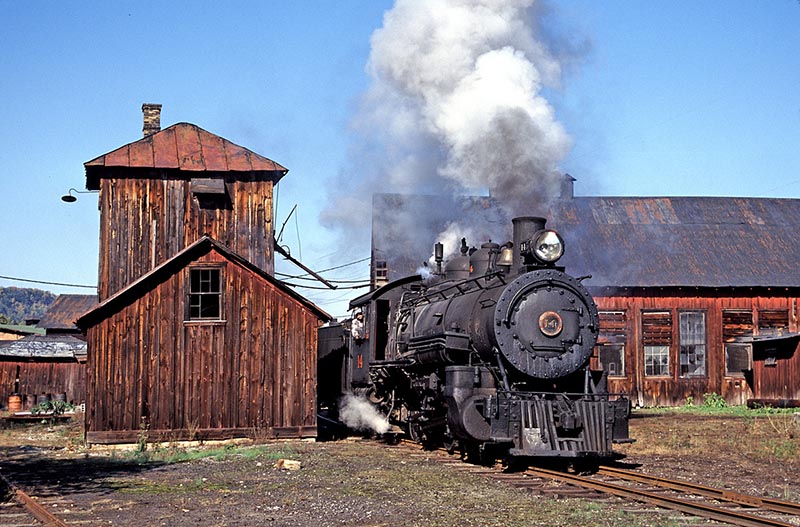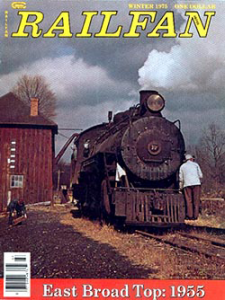 By John Krause/as told to Jim Boyd
By John Krause/as told to Jim Boyd
When you’re talking narrow gauge, you’re talking Colorado, and even my affection for the Pennsylvania straight gauge had its beginnings in a motel in Alamosa in September 1954. I was wrapping up a photography trip on the Rio Grande narrow gauge when I encountered my old friend John Hungerford in Alamosa. A prolific and pioneer railroad author, John was planning to write a book on the East Broad Top, and he knew that I would have to pass near there on my return home to Long Island. He asked me to “stop by and get interested in the EBT…” and get some photography on it for his book. I had been to the EBT once before, in the winter of 1949, so I was not a complete stranger to the coal-hauling Mikados of the Aughwick Valley—but with the Pennsy and most of the rest of the country still in steam at the time, it was an interesting novelty, but hardly worth becoming an obsession. Besides, the Colorado narrow gauges were faltering and heading for the last bust, while the EBT was secure in tradition and coal.
Mr. Hungerford called C. Roy Wilburn, the EBT’s Operating Vice President, in Orbisonia and told him I was coming, so I set out to reacquaint myself with Eastern narrow gauge railroading. By 1954 the EBT had already discontinued scheduled mixed train operation, and there were signs of hard times ahead. The EBT, however, seemed immobile in time while the rest of the railroad world around it was changing. Geeps and Alcos were still far away from Orbisonia, and the coal trains down from Robertsdale still carried a combine and looked like the mixeds of a few years before. The yard and shop facility at Orbisonia looked like it hadn’t changed a bit in fifty years. My visit was brief but productive, and I wouldn’t need much encouragement to return.
Like a reformed smoker-even though—I’m not a reformed smoker—it was my turn to interest another Colorado fanatic in the EBT. Artist and photographer Phil Ronfor was one of those who believed that three feet only means narrow gauge if you can smell the Aspen and see snow-capped peaks. He, too, had made one previous trip to the EBT, on a fan trip over the Shade Gap Branch right after World War II. He agreed to accompany me on a fourday outing in November 1954. We called Roy Wilburn to make sure everything was running, and ventured westward on the Pennsylvania Turnpike. What followed turned out to be the basic formula for eight more trips to the EBT before it abandoned in early 1956.
We would turn off the Turnpike at Exit 13 and head north on highway 522. Arriving at Orbisonia about midnight, we would stop in at the old stone farmhouse south of the turntable that served as an office and check the callboard for the next day. Then we’d drive on up to Mount Union and tie up at Capt. Jack’s Motel on Route 22 for the night. The first train would usually go to work at 5:00 a.m. at Orbisonia, and would either run up to Mount Union for empties or make up his train in the Orbisonia yard. The sun would be just about burning the morning haze out of the valleys when we would set up for our first shots at Pogue trestle.
By the fall of 1954, the East Broad Top’s role in the local economy had become rather simple. The Rockhill Coal Company and a number of private operators had coal mines between Broad Top Mountain and Sideling Hill, and the railroad was their route to the cleaning plant at Mount Union and a connection with the Pennsylvania Railroad. Until a year ago, three manufacturers of silica firebrick at Mount Union depended upon the railroad for coal for their furnaces, and in at least one instance for the ganister rock used to line their own kilns. Now, one had closed down completely, and the other two had converted to gas or oil, although the ganister was still being hauled. Mail service that had once been handled on scheduled EBT trains in a combine had now gone over to trucks, and the local freight business was minimal. An occasional carload of scrap-usually a standard gauge gon on narrow gauge truckswould be shipped out of Three Springs, and the local telephone company would still get a similar carload of telephone poles into Rockhill Furnace from time to time. A smattering of railroad ties, mining machinery and lumber would travel over the three-foot rails, but the booming business of earlier years could only be found in the rumbling coal-laden hoppers coming off the mountain, and even there, the loss of the brick works cut the heart out of the coal business.
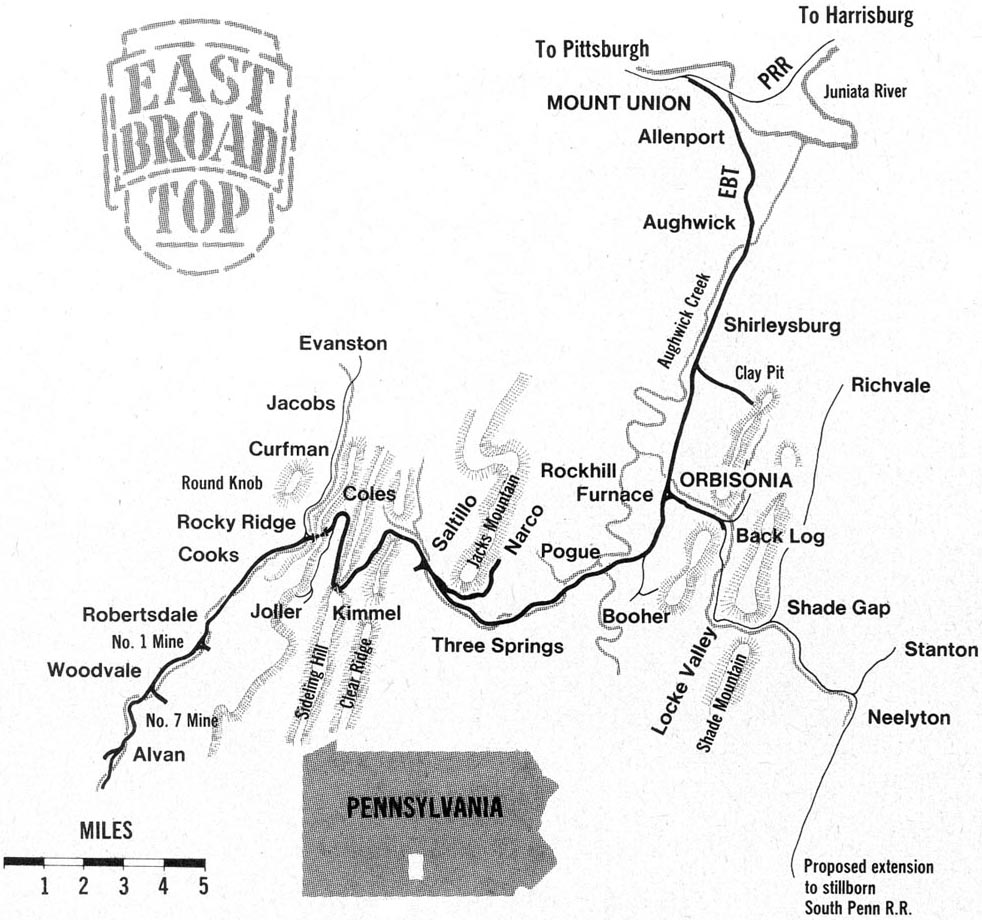
The railroad was operating on a fiveday-a-week schedule, and a typical operating day would find two trains on the line. The first job would go to work at Orbisonia about dawn and would usually get one of the big Mikados (16, 17 or 18) and a combine. As mentioned before, it would either make up its train out of the yard at Orbisonia or run to Mount Union for empties. It would then go to Saltillo, where it would shove up the Narco Spur and swap empty hoppers for loads at the ganister rock loader. The loads would be left on the siding next to the main line to be picked up on the return trip. The train would take water at the classic shrouded wood tank at Saltillo, maybe take on sand from a boxcar spotted by the depot, and then begin its long westward climb toward Robertsdale up grades reaching four percent. It would pass through two tunnels, Sideling Hill and Rocky Ridge, on its twisting way to Robertsdale. The first mine to be encountered en route was on a branch that left the main at the east end of Rocky Ridge tunnel and followed the flank of Wrays Hill to the Miller Coal Co. mine at Joller. By 1954, however, this mine was shut down. Because of the twisting climb over two mountains, we would select three or four photo locations on each trip, but actually “following” the train was virtually impossible because of poor roads.
Rockhill Coal Company Mine No. 1 at Robertsdale was the reason the entire EBT had been envisioned back before the Civil War, and this mine had only recently been closed in favor of the more economic strip mines at the end of the line. The mines in the Robertsdale area were numbered from 1 to 10, with the addition of four more stripping operations numbered 11A, 11B, 12A and 12B in the vicinity of Alvan, the end of the line. Slope mines 1, 5 and 9 were among the last of their kind to be worked on the EBT, but by now all the coal was coming from the strip operations, although the No. 9 loader was still being used.
The train would pull past the brick depot in the “center” of Robertsdale and into the yard that had served Mine No. 1. Here it would switch out its train, couple the combine behind the tender and then get on behind a cut of emptys to shove them to Alvan. The mines beyond Robertsdale were difficult to reach by car, and we seldom ventured out that way.
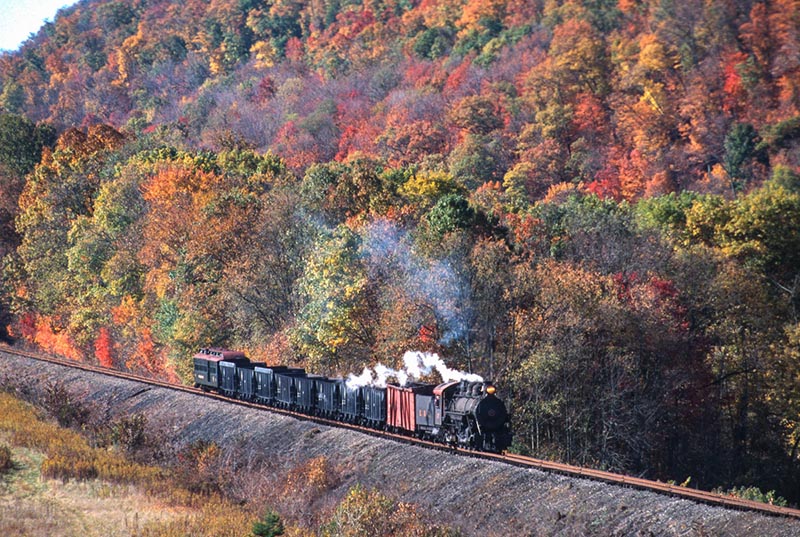
An East Broad Top coal train heads north from Orbisonia on a photo charter in October 2001. The special train features a typical EBT consist of the 1950s — an less-than-carload boxcar on the head end, coal hoppers (albeit in 1950 there would have been more hoppers and they would have been loads going north), and a combine (Which the EBT crews preferred to use over a caboose because of the better ride). Steve Barry photo
While the first train was working the mines, the second train would be making its way up from Orbisonia. It would usually have one of the mid-sized Mikes (14 or 15) and carry a caboose instead of a combine-the EBT only owned two cabooses. The first train would usually return from the mines to Robertsdale, turn the engine and combine on the wye by the freight house, and put his train together for the return trip. Depending on how the second train was doing, the first train would either hold at the passing siding at the edge of Robertsdale, or proceed back eastward to meet somewhere out on the line. On one memorable day, the first train pulled on down the main line to Kimmel siding, just west of the portal of Sideling Hill Tunnel. In fresh, deep snow, he held the main and the upbound second train came blasting out of the tunnel, around the bend and into the still-snow-covered siding.
While the second train worked the mines at Robertsdale, the first train would return to Saltillo where he would take water and pick up the loads of ganister rock he’d brought down in the morning. The first train would then run all the way to the other end of the line at Mount Union, occasionally pausing to do work at Orbisonia.
Most of the trackage in the Mount Union yard is dual gauge, and the EBT kept two standard gauge 0-6-0’s there in a brick enginehouse to handle the switching of both the narrow and standard gauge sides of the coal cleaning plant, the brick works, and the Pennst interchange.
Before 1953, when there was still scheduled mixed-train passenger service, the inbound narrow gauge train would set out loaded hoppers in the yard, grab the combine and pull on downtown on dual gauge track to the old passenger depot along what had been the Pennsy main line. (The Pennsy had built a new bridge over the Juniata River and relocated their tracks through town.) A small truck would have backed up to the combine and the passengers would have disembarked onto the platform. With passenger service gone, however, the narrow gauge engine and combine would now simply turn on the wye and retire to the water plug while the 0-6-0 went to work on the train. Incidentally, the end of scheduled passenger service also ended the regular use of EBT’s classic little gas-electric motor car M1. The motor car would make the Saturday passenger and mail run where there was no coal train. During coal strikes or other emergencies, it would even be used as a locomotive when no steamers were fired up, and could reportedly handle two loads of ganister rock.
Operations in the Mount Union yard were about as fascinating as anything you could find in 1954. The coal facility was a massive and angular black building that was known in the trade as a Chance Sand Floatation Cleaning Plant. The narrow gauge coal loads would be spotted in the yard above the loader on tracks that corresponded to the mine from which they had originated. Since each mine produced a slightly different grade of coal, the tipple foreman would have the hoppers rolled down over the sorting pits in the correct order to give the specific mix of coal that was needed. There were four pits, and they could be fed via two coneyors into the bull shaker at different rates to give a desired blend. This blended raw coal would then be washed and sized before being delivered into the Pennsy’s standard gauge hoppers. Washed coal in the predetermined blend would be crushed and screened to various sizes: Minus 3/8″ Slack, 3/8″x1.5″ Pea, 1.5″ or 2″ Stoker, 1.5″x3″ Range, 3″x5.5″ Furnace or 8″ Lump. They could even deliver plain old run-a-mine coal if desired. Sometimes the cleaned and graded coal would be leaded back into narrow gauge hoppers for the railroad’s own use in their locomotive coal dock at Orbisonia.
Coal destined for the three brick works at Mount Union could be delivered from the cleaning plant in either standard or narrow gauge cars, since all of their trackage was dual gauge. In the latter years it had become generally accepted practice to deliver the coal in borrowed Pennsy hoppers, since the supply of narrow gauge cars was being used elsewhere. Of the three brick works, North American Refractories, General Refractories and Harbison Walker, only North American remained as a customer of the EBT in 1954. Harbison Walker had converted to gas and was trucking in all of its raw materials, and General Refractories—who used to get their ganister from the Stanton Quarry on the Shade Gap branch—closed down completely. North American was no longer a customer for coal, since they had just converted to oil, but they still got much of their ganister from the Narco Spur at Saltillo. The brick that was manufactured in Mount Union was specially shaped silica firebrick that was used in coke ovens and steel mills.
One of the most noticeable features of the Mount Union yard was the old timber transfer gantry that was being used to retruck standard gauge cars for narrow gauge operation. Ever since the EBT had been upgraded by Robert Seibert back at the turn of the century, it had been strong enough to handle standard gauge loads, but it wasn’t until 1933 that somebody realized it and the idea was implemented. The old transfer crane was used to lift one end of a standard gauge car at a time while its trucks were removed and replaced with narrow gauge ones. Special aluminum adaptor coupler knuckles were substituted, and the narrow gauge answer to a highand-wide was ready to roll. This technique was used for a variety of traffic. In the later years this included telephone poles on flats, scrap coming out of Three Springs in gons, carloads of railroad ties, and even 50- and 70-ton hoppers out of the mine at Joller. Clearances were such that typical standard gauge cars would even fit through the tunnels.
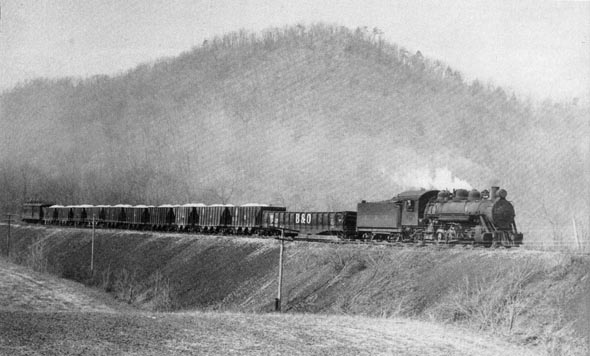 A standard gauge gondola riding narrow gauge trucks was first out on a train of ganister rock a few miles north of Orbisonia in 1955. Photo by John Krause
A standard gauge gondola riding narrow gauge trucks was first out on a train of ganister rock a few miles north of Orbisonia in 1955. Photo by John Krause
When its work was completed at Mount Union and the return train was made up, the first train would head back toward Orbisonia to tie up for the night. Again, depending on how the second train was doing, there would be a meet either at Mount Union, Orbisonia or a siding in between.
The second train would continue on to Mount Union, complete its work and also return to Orbisonia for the night. Orbisonia: there has been considerable confusion over whether the EBT was in Orbisonia or Rockhill Furnace. In geographic reality, the depot, yard and engine shop are in Rockhill Furnace, Pa. However, when the line was first built into this part of the Aughwick Valley, the depot was actually a half mile from the community of Rockhill Furnace, and only a few hundred feet from Orbisonia, which was across the creek. The depot was named Orbisonia, but the town of Rockhill Furnace gradually grew to surround the railroad, while Orbisonia stayed across the creek. The final irony came when the depot that stands today was built in 1907, and the Orbisonia depot housed the Rockhill Furnace post office!
The EBT had seen many fortunes and many changes over the years, but the essence of its operation remained intact in 1954. The Shade Gap branch, that was once used to help build the Tuscarora Tunnel of the stillborn South Pennsylvania Railroad in 1885 and then revived again in the 1930’s when that same tunnel was converted for use on the Pennsylvania Turnpike, had been stubbed back to Back Log Creek near the old iron furnaces that gave Rockhill Furnace its name. The Rocky Ridge branch to Evanston had also been torn up, but most of the rest of the railroad remained much as it had for well over half a century.
Phil Ronfor, Mike Koch and I made quite a few trips to the EBT in its last two years of operation. During 1955, the “official” atmosphere around the EBT changed; there were “security” problems and railfans were less than welcome. Our friend Roy Wilburn eased things for us, but would always greet us with, “I have to inform you that you are not permitted to be on the property,” and then we would continue right on as usual. The traffic would vary from trip to trip, and sometimes there would be only one train a day, sometimes only one a week. Sometimes the train would go only as far as Saltillo to get the ganister rock and deliver it to Mount Union. By early 1956 it was becoming clear that the end wasn’t far off; the abandonment petition had been posted on November 21, 1955, and it was only a matter of time.
On March 31, 1956, we were on hand as the last coal train left Robertsdale behind Mikado 16. The next week we called Mr. Wilburn to find out about any “official” last run. “You know I can’t tell you anything, but come on out here on April 6 and talk to me about it.”, was his reply. On that day we watched 17 pull the loads of rock off the Narco Spur, gather up the boxcar of sand at Saltillo and head for Mount Union for the last time. Mr. Scott, the agent at Orbisonia, handed up the last train order and gave me a copy. 17 took the train to Mount Union and returned with only the combine. The narrow gauge was dead. A week later, 0-6-0 No. 3 cleaned up the yard in Mount Union, delivered the last interchange to the Pennsy, and closed the books on the East Broad Top. We thought.
The events of the next four years when the EBT was sold to Mr. Kovalchick, the scrapper who didn’t scrap her, are among the most fortunate in the history of America’s narrow gauge railroads. Mr. Wilburn was kept on the payroll to oversee the abandonment, and ultimately wound up supervising its rebirth as a tourist hauler. As incredible as it may seem, today, almost 20 years after its abandonment, the entire EBT line from Mount Union to Alvan is intact, and the entire Orbisonia yard and about six miles of the main line are in active use. Only one locomotive has left the property since 1943, and that one, 0-6-0 No. 6, is back under steam and hauling tourists in Indiana! In 1975, Mikados 12, 14 and 17 are serviceable, and 15, 16 and 18 are intact in the roundhouse. 0-6-0 No. 3 is still at Mount Union.
The man who “got me interested” in the EBT, John Hungerford, passed away before he could write his book, but over in Orbisonia Roy Wilburn is still running his narrow gauge railroad. The story isn’t over yet.


